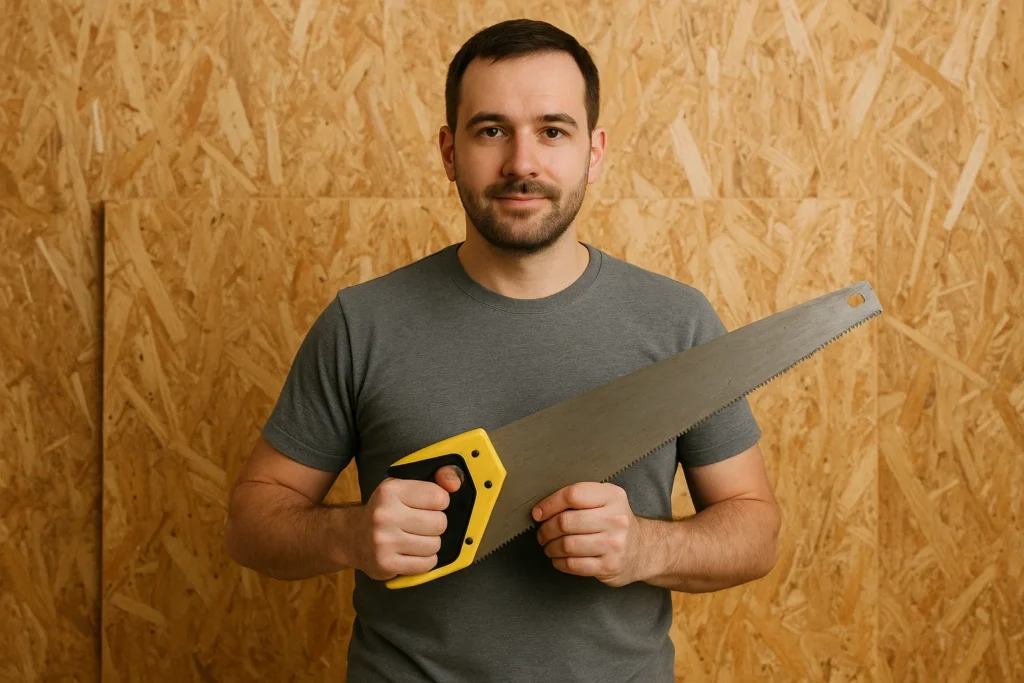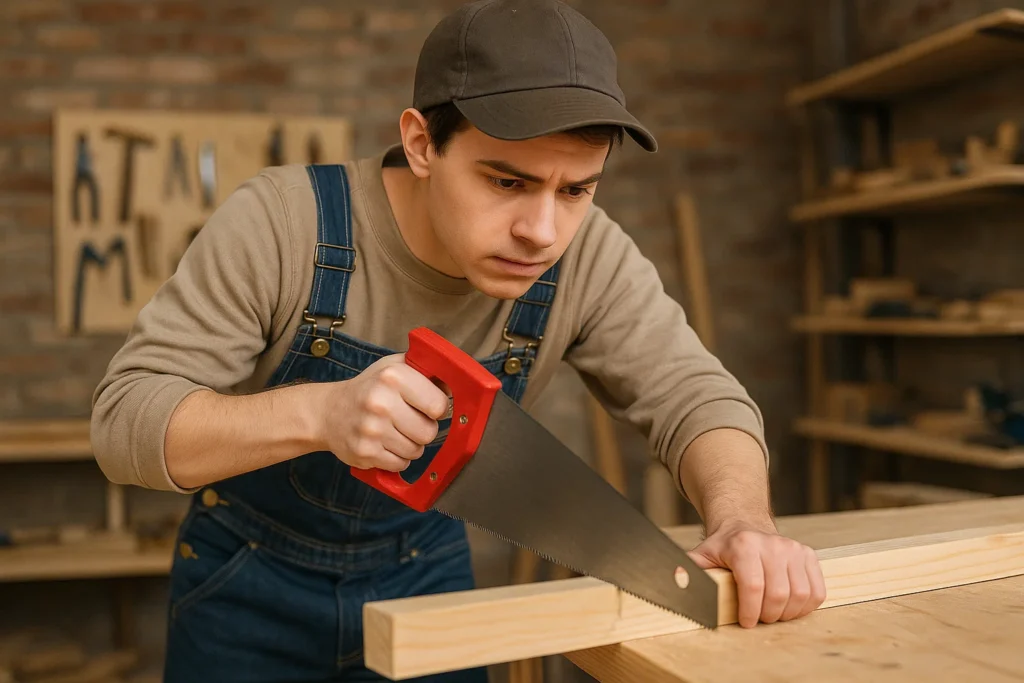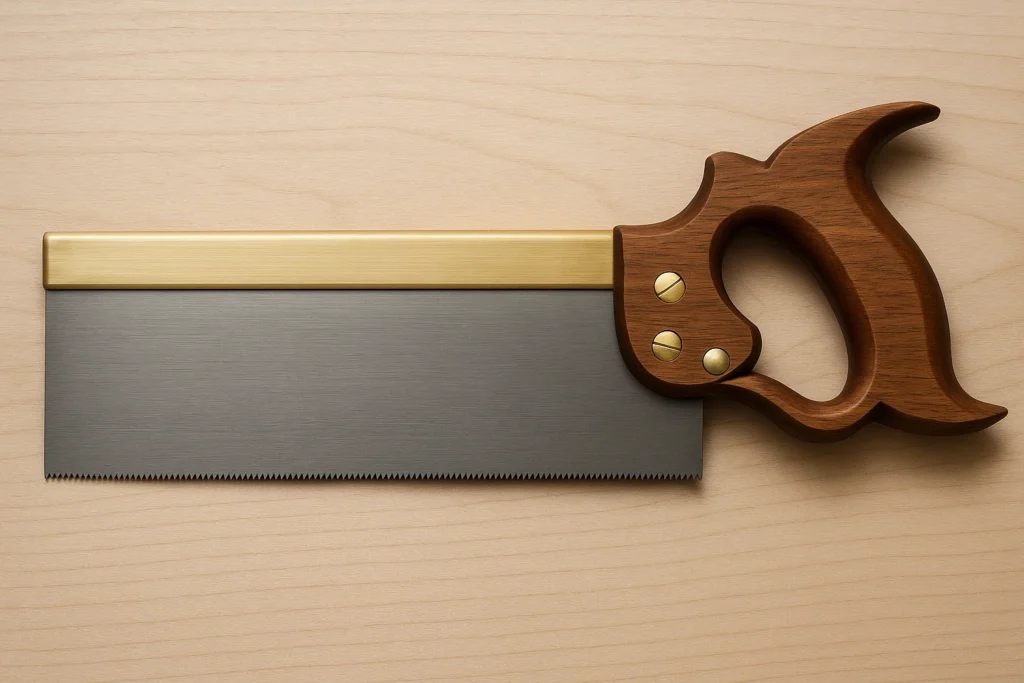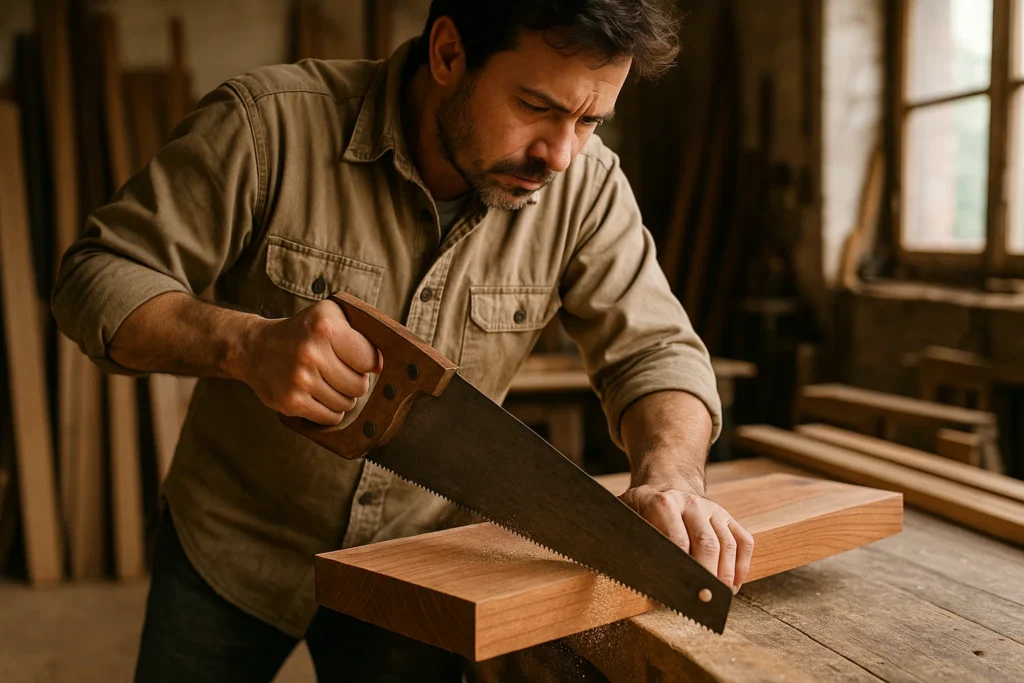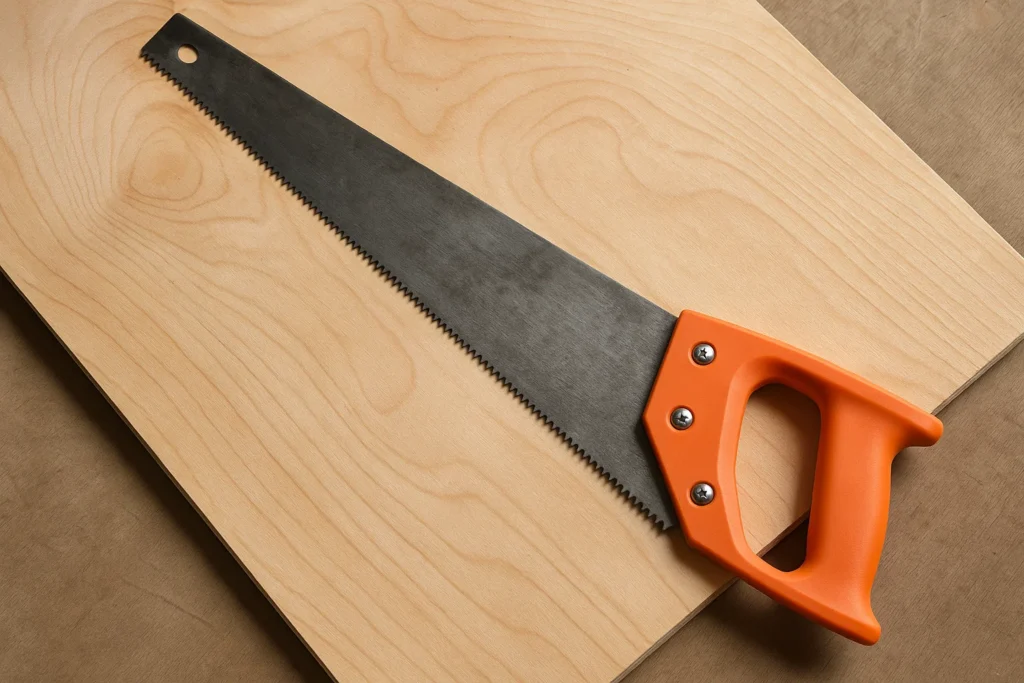OSB, More Like Opp
Oriented Strand Board poses unique cutting challenges; its mixed‑grain flakes, resin content and rough texture can quickly dull blades, cause splintering and demand extra effort.
Choosing the right hand saw helps you maintain clean edges, avoid tear‑out and reduce fatigue over long cuts.
In this guide, we compare top saws by tooth design, blade stiffness and ergonomic features so you can cut OSB more efficiently and with better results.
Bullet Points
- OSB’s mixed‑grain flakes and resin dull blades faster than solid wood.
- Ideal hand saws for OSB have 7–10 TPI for balanced speed and finish.
- Hardened or induction‑treated teeth resist resin wear and stay sharper longer.
- Blade lengths of 15–22″ offer control in tight spaces or power for full‑sheet cuts.
- A rigid, thick blade prevents bending and ensures straight cuts.
- Ergonomic, non‑slip handles reduce fatigue during extended sawing.
- Anti‑friction coatings help resist resin buildup and improve cut smoothness.
- Regular blade cleaning and proper storage extend saw life and cutting performance.
Some or all Images are generated by AI for illustration.
Best Hand Saws For OSB
Hand Saw | Best For | Blade Length | TPI |
|---|---|---|---|
18 in (45.7 cm) | 7 TPI | ||
15 in (38 cm) | 9 TPI | ||
18.7 in (47.5 cm) | 9 TPI | ||
15 in (38 cm) | 8 TPI | ||
15 in (38 cm) | 10 TPI |
Note: We don’t test products ourselves. Instead, we go through user reviews and/or community discussions to find and recommend the best options.
1. HAUTMEC X-Sharp
The HAUTMEC X‑Sharp Pro 18″ hand saw cuts OSB fast and straight with a sturdy blade and comfortable grip. Packaging can arrive damaged.
Key Features
- Blade Length: 18 in (45.7 cm) blade gives long reach for deep cuts.
- TPI: 7 TPI (7 teeth per inch) for fast, aggressive cutting on push and pull strokes.
- Blade Material: High‑speed steel blade resists wear and stays sharp longer.
- Handle Type and Material: Ergonomic marking handle in ABS and TPR rubber for a non‑slip grip.
- Saw Type: Universal hand saw works on wood, PVC, plastic, and more.
- Cutting Angle / Set: Built‑in 45° and 90° angle guides for quick, accurate marking.
- Weight: 1.1 lb (0.5 kg) keeps the saw light and easy to handle.
Pros & Cons
Pros:
- Sharpness: Strong, precision‑ground teeth slice through OSB with minimal effort for clean, consistent kerfs.
- Stability: Thick, wide blade resists bending under pressure, keeping cuts straight when working large OSB panels.
- Grip Comfort: Rubber‑coated, ergonomic handle stays secure and reduces hand fatigue during extended cutting.
- Cutting Speed: Aggressive 7 TPI tooth pattern rips through wood fibers quickly, letting you finish OSB cuts faster.
Cons:
- Packaging: Saw can often ships in a crushed or open box, risking damage before use.
- Longevity: Long‑term blade life is unclear from initial impressions.
Note: These pros and cons are based on user review trends and latent consensus.
Our Verdict
Reliable choice for OSB cutting tasks.
Buy If:
- You need sharp teeth for clean, precise OSB kerfs.
- You require a stable, thick blade to keep cuts straight on large panels.
- You plan extended cutting sessions and want a comfortable, non‑slip grip.
- You value fast, aggressive cutting to finish OSB jobs quickly.
Don’t Buy If:
- You worry about receiving damaged tools due to poor packaging.
- You need proven long‑term blade life for heavy daily use.
- You plan to cut unusually dense or hardwood‑infused OSB variants.
Overall, the HAUTMEC X‑Sharp Pro excels at clean, straight OSB cuts with minimal effort. Just beware of potential shipping damage and unknown blade longevity before relying on it for heavy, long‑term use.
2. GreatNeck 74001
A sharp, compact 15 in hand saw that makes fast, clean OSB cuts with its aggressive teeth and comfy grip. Built‑in ruler and angle guides boost precision for DIY and pro projects.
Key Features
- Blade Length: 15 in (38 cm)
- TPI: 9 TPI (teeth per inch)
- Blade Material: Alloy steel
- Handle Type and Material: Composite anti‑slip comfort handle
- Saw Type: Aggressive tooth hand saw
- Cutting Angle / Set: Built‑in 45° and 90° angle markings
- Weight: 13.6 oz (385 g)
Pros & Cons
Pros:
- Sharp Teeth: Stays sharp after several uses, so it slices cleanly through OSB with minimal effort.
- Fast Cutting: Aggressive tri‑bevel tooth design and deep gullets clear chips quickly, speeding up OSB sheet cuts.
- Comfort Grip: Ergonomic composite anti‑slip handle reduces hand fatigue and maintains control during long OSB panels.
- Compact Size: 15 in (38 cm) blade maneuvers easily in corners and tight framing spaces on OSB installations.
- Precision Guides: Built‑in 12 in ruler plus 45°/90° marks let you measure and cut OSB accurately without extra tools.
- Durable Blade: 1 mm alloy steel resists bending and corrosion, standing up to rough jobsite use on OSB.
Cons:
- Logo Wear: Company name printed on blade scrapes off after a few cuts, affecting the saw’s appearance.
- Longevity Uncertain: Real-world lifespan under heavy OSB cutting hasn’t been confirmed.
Note: These pros and cons are based on user review trends and latent consensus.
Our Verdict
Reliable OSB cutting saw.
Buy If:
- You need fast chip removal for quick OSB cuts.
- You value an ergonomic anti‑slip grip on long panels.
- You work in tight framing spaces needing a compact blade.
- You want built‑in ruler and angle markers for on‑the‑fly layout.
- You need a corrosion‑resistant blade for rough jobsite OSB work.
Don’t Buy If:
- You rely on an initial back‑cut for perfect accuracy.
- You need an ultra‑smooth blade finish, sticky surface slows feed.
- You require proven long‑term durability under heavy OSB use.
Overall, this saw excels at fast, comfortable rough cuts and precise layout thanks to its grip and guides. However, if your work demands flawless starter cuts or guaranteed longevity under constant OSB use, you may want a more specialized option.
3. Bahco ErgoXT
Bahco 2600‑19‑XT‑HP delivers smooth, accurate OSB cuts with its ergonomic handle and lasting sharpness. Ensure it meets your initial sharpness and fixed‑blade needs before buying.
Key Features
- Blade Length: 18.7 in (47.5 cm)
- TPI: 9 TPI
- Blade Material: High Speed Steel
- Handle Type and Material: Western style TPR handle
- Saw Type: Handsaw ErgoXT Superior
- Cutting Angle / Set: [Missing data]
- Weight: 0.88 lb (0.4 kg)
Pros & Cons
Pros:
- Ergonomic Grip: Tilt‑adjustable handle sits naturally in hand, reducing fatigue during long cuts.
- Long‑Lasting Sharpness: Hard‑point XT teeth stay sharp over years of use, minimizing frequent sharpening.
- Smooth Cutting: Low‑friction coating and stable thick blade slice through wood like butter for clean OSB cuts.
- Angle Markings: Built‑in 45° and 90° guides on the handle enable precise, repeatable angle cuts without extra tools.
- Chip Clearance: Dual‑direction chip removal prevents jamming and maintains cutting speed on particle‑based boards.
Cons:
- Inconsistent Sharpness: Some units arrive less sharp out of the box, requiring extra effort to start a clean cut.
- Thick‑Wood Strain: Cutting efficiency may drop on thicker sections (over 4 in), compared to finer‑tooth alternatives.
Note: These pros and cons are based on user review trends and latent consensus.
Our Verdict
Reliable choice for smooth OSB cutting.
Buy If:
- You want clean, jam-free cuts thanks to chip clearance.
- You need ergonomic, tilt-adjustable handle for long sessions.
- You require precise angle cuts with built-in 45° and 90° guides.
- You value durable teeth that stay sharp over years.
Don’t Buy If:
- You need a razor-sharp edge straight from the box.
- You cut sections thicker than 4 inch regularly.
With its ergonomic grip, angle guides, and low-friction coating, this saw excels at clean OSB cutting. Verify initial sharpness and note the blade is fixed before committing for heavy-duty needs.
4. Jorgensen Fine-Cut
Sharp, durable, and ergonomic, this 15 in hand saw delivers precise, fast OSB cuts with minimal fatigue. A budget-friendly fixed-blade solution ideal for DIYers and pros alike.
Key Features
- Blade Length: 15 in (38 cm)
- TPI: 8 TPI (8 teeth per inch)
- Blade Material: High‑carbon steel, 0.033 in (0.85 mm) thick
- Handle Type and Material: Ergonomic non‑slip ABS+TPE soft‑grip handle [Unclear on aluminum ultrasonic weld core]
- Saw Type: Pro hand saw
- Cutting Angle / Set: [Missing data]
- Weight: [Missing data]
Pros & Cons
Pros:
- Sharpness: Blade is razor‑sharp straight from the packaging, ensuring clean cuts through OSB with minimal tear‑out.
- Cutting Speed: Fine‑cut 8 TPI design slices through panels quickly, reducing effort on long runs.
- Accuracy: Teeth stay true on push and pull strokes, producing straight lines for snug board fitting.
- Comfort: Soft‑grip ABS+TPE handle eases hand fatigue during extended cutting of large sheets.
- Portability: Slim profile fits neatly in truck toolboxes, making it easy to carry between job sites.
- Value: High quality at a budget price point boosts cost efficiency for frequent OSB work.
Cons:
- Delivery Delay: One user noted it “took too long,” which may impact tight renovation timelines. (This comes down more to the shipping, rather than product itself.)
Note: These pros and cons are based on user review trends and latent consensus.
Our Verdict
Reliable choice for clean OSB cuts.
Buy If:
- You value razor‑sharp performance straight from the package.
- You cut long OSB runs and need steady, accurate lines.
- You work extended sessions and want a fatigue‑reducing handle.
- You store tools in tight spaces and need a slim profile.
Don’t Buy If:
- You need guaranteed fast delivery for urgent jobs.
- You plan pruning or branch trimming rather than sheet cutting.
- You require coarser teeth than 8 TPI for rough, rapid cuts.
Overall, this saw delivers sharp, precise cuts in OSB at a budget‑friendly price, with ergonomic comfort for long runs. Its fixed 8 TPI blade suits panel work but isn’t ideal for pruning or tasks needing coarse teeth or blade swaps.
5. IRWIN Universal Handsaw
The Irwin Universal Handsaw cuts OSB panels quickly and resists bending, but leaves a rough edge and can’t be resharpened.
Key Features
- Blade Length: 15 in (38 cm) for long, efficient strokes through OSB
- TPI: 11 PPI (10 TPI)
- Blade Material: High‑speed steel for lasting sharpness and durability
- Handle Type and Material: Comfort‑grip handle molded from high‑density resin to reduce hand fatigue
- Saw Type: Universal handsaw designed for fast cuts in engineered wood and varied materials
- Cutting Angle / Set: Universal tooth grind with tapered‑pitch nose for quick material removal and stable cuts
- Weight: [Missing data]
Pros & Cons
Pros:
- Fast Cutting: Triple‑ground teeth slice through OSB quickly, cutting up to three times faster to speed project work.
- Sharp Teeth: Hardened high‑speed steel blade stays sharp over time, delivering cleaner cuts without frequent sharpening.
- Comfort Handle: Ergonomic resin grip fits the hand well, reducing fatigue during extended OSB sawing.
- Sturdy Blade: Thicker blade body resists bending and wobbling when slicing through large OSB panels.
Cons:
- Rough Finish: Aggressive tooth grind leaves uneven edges on OSB boards, often requiring extra sanding for a smooth fit.
- Thin Profile: Blade can flex or bow if forced, risking inaccurate cuts in denser OSB sections.
- Non‑Sharpenable: Hardened teeth cannot be resharpened, dull blades must be fully replaced.
- Binding Risk: Saw sometimes sticks or binds in engineered wood, interrupting smooth, continuous strokes.
Note: These pros and cons are based on user review trends and latent consensus.
Our Verdict
A reliable pick for speedy OSB panel cuts.
Buy If:
- You need to slice through OSB quickly with minimal effort.
- You want a handle that reduces hand fatigue during long jobs.
- You value a blade that resists bending under pressure.
Don’t Buy If:
- You require ultra‑smooth edges without extra sanding.
- You plan to resharpen your saw instead of replacing it.
- You need completely snag‑free strokes in dense engineered boards.
This Irwin handsaw excels at fast, durable cuts in OSB with a comfortable grip, making it ideal for rough‑in and framing tasks.
However, its coarse finish and non‑sharpenable blade mean it’s less suited for precision trim work or if you prefer to maintain blades long‑term.
Why OSB Needs the Right Saw
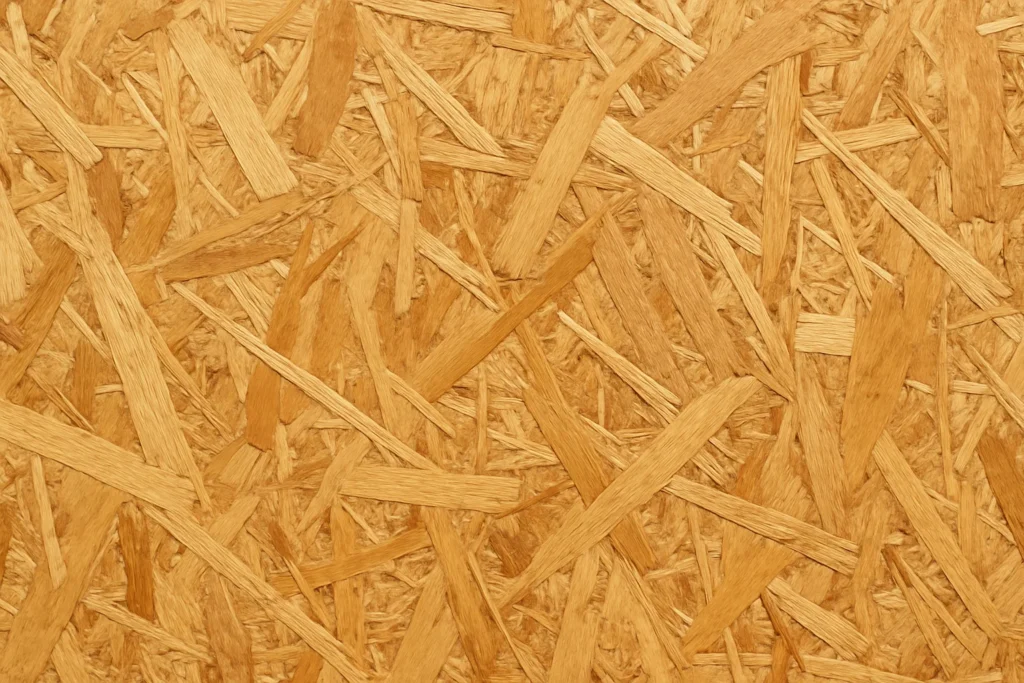
OSB (Oriented Strand Board) is made from layers of wood flakes compressed with glue and resin. While it may look similar to plywood or even MDF, it cuts very differently.
That’s why using just any hand saw doesn’t work well. OSB’s layered structure, mixed grain direction, and high glue content create unique challenges.
Here’s why the right saw matters:
1. Rough Texture + Random Grain
Unlike solid wood, OSB has no uniform grain. Each strand points a different direction, so blades hit varying resistance. This causes:
- More friction
- A rougher finish
- Extra force needed per stroke
2. Glue and Resin Build-Up
The adhesive used in OSB dulls saw teeth faster than plain wood. A typical hand saw may start sharp, but you’ll notice it dragging or snagging after just a few panels.
Hardened teeth or special coatings help resist this.
3. Splintering and Fraying
OSB tends to chip along the cut line. If the saw teeth aren’t the right size or shape, the board edges can splinter badly.
A good saw reduces edge tear-out and keeps cuts cleaner—especially helpful if the cut will be visible.
4. Fatigue Over Time
Cutting OSB by hand is tiring. Using the wrong saw adds unnecessary effort. The right one cuts faster, reduces arm strain, and stays sharp longer, making long sessions easier to handle.
Top Features to Look for in an OSB Hand Saw
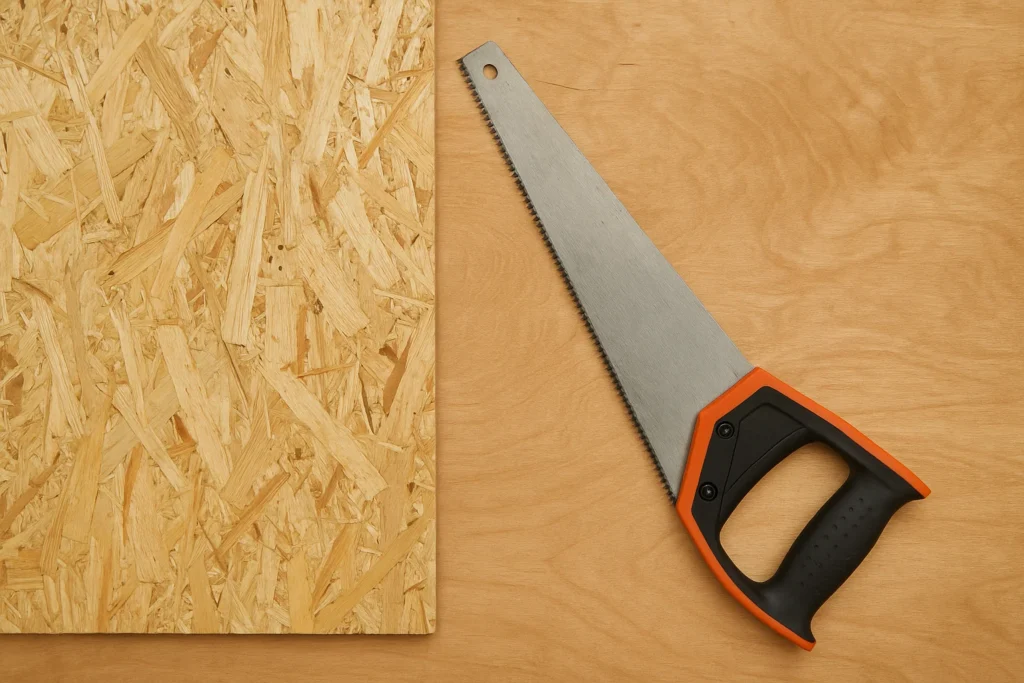
Not all hand saws are built to handle the unique structure of OSB. The wrong features will make cutting slow, messy, or physically exhausting.
This section breaks down exactly what to look for so you’re not guessing at the shelf or screen.
1. Tooth Count (TPI – Teeth Per Inch)
Ideal Range: 7–10 TPI
This is one of the most important specs. TPI controls how aggressive the saw is.
- Lower TPI (fewer teeth): Cuts faster but rougher. Too low (like 4–5 TPI) and it’ll tear through OSB too roughly.
- Higher TPI (more teeth): Smoother cuts but slower. Over 11 TPI makes it harder to push through OSB’s dense, flaky surface.
Why 7–10 TPI?
This range gives a good balance; fast enough to get through OSB without bogging down, but not so aggressive that it shreds the edges. It’s ideal for general construction cuts.
2. Tooth Type
Look for hardpoint or induction-hardened teeth.
- These are heat-treated to stay sharp much longer.
- OSB’s resins wear down regular teeth quickly, so soft teeth dull fast.
- Hardened teeth also reduce the need for sharpening (many can’t be sharpened anyway).
If the packaging says “never needs sharpening,” it’s likely hardpoint.
3. Blade Length
Ideal Range: 15–22 inches
The length affects cutting speed and control.
- 15–18 inches: Easier to handle in tight areas. Great for control.
- 20–22 inches: More cutting power per stroke. Better for long, straight cuts across full sheets.
Short blades are fine if you’re making small adjustments or working inside a framed structure. For general-purpose use, 20 inches hits the sweet spot.
4. Blade Thickness and Stiffness
A thin blade may bend or wobble while cutting OSB.
- You want a rigid, thick blade that holds a straight line.
- Stiff blades resist twisting and help make accurate cuts without veering off-course.
If you see a blade that flexes easily or feels flimsy in your hand, it’ll likely struggle with OSB.
5. Handle Comfort and Grip
You’ll be applying a lot of pressure while sawing.
- Look for ergonomic handles that fit your hand well.
- Rubberized or textured grips reduce slipping, especially if your hands get sweaty or dusty.
- A slight forward angle in the handle helps guide each stroke naturally.
Avoid boxy plastic handles with sharp edges. They’ll hurt your hand before the job is done.
6. Coating or Blade Finish
Some blades come with a non-stick coating or anti-friction finish.
Why it matters:
- OSB resin causes buildup on untreated blades.
- Coated blades resist that buildup, so the saw moves more smoothly.
- It also helps reduce heat, which can warp the blade slightly over time.
This is a bonus feature, not critical, but it does improve performance and ease of cleaning.
Types of Cuts You’ll Make on OSB
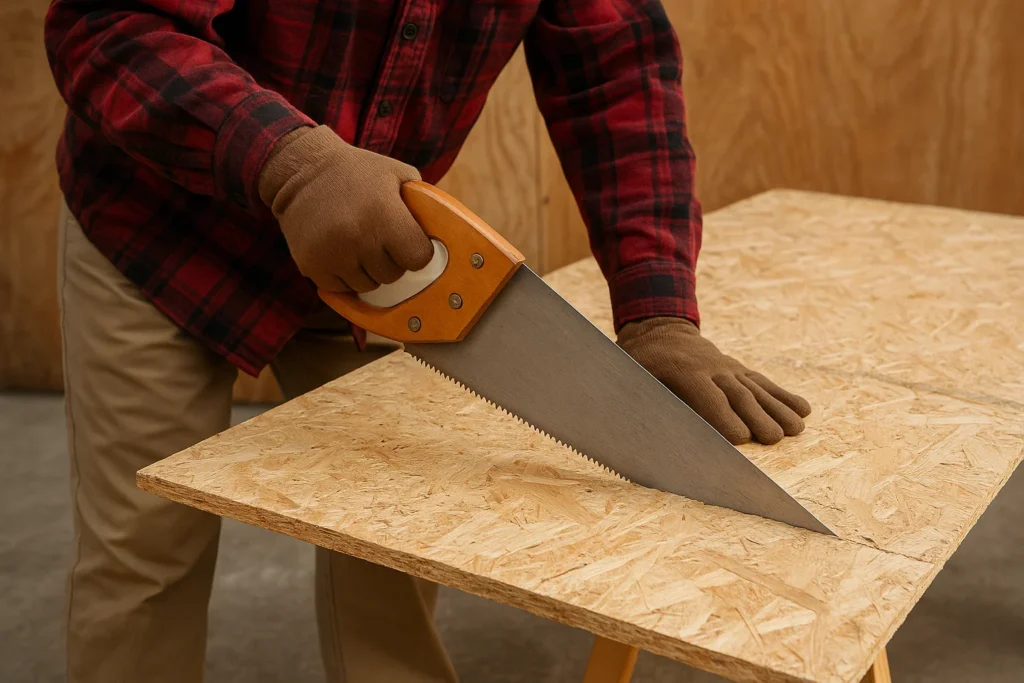
When choosing a hand saw for OSB, it helps to know what kinds of cuts you’ll actually be making. Not all OSB jobs are the same.
The type of cut affects which saw style or blade length will feel best in your hand.
1. Straight Crosscuts
Most OSB cuts are straight and rough, like trimming down 4×8 sheets to size. These are common when:
- Sheathing a wall
- Subfloor installation
- Cutting panels for roofing
For this, you’ll want a longer, stiff-blade saw (20–22 inches) with 7–9 TPI. The longer blade gives you a smoother stroke and faster progress across large sheets.
2. Plunge Cuts or Notching
Sometimes you’ll need to start a cut inside the board, like for:
- Outlets or switch boxes
- HVAC vent holes
- Window or door frames
In these cases, you’ll need a saw that can start in the middle of a panel, either by:
- Using the tip to jab through (only if the saw is strong enough)
- Drilling a starter hole first, then inserting the blade
A shorter blade (15–18 inches) with a sharp point and a narrow tip helps you steer better and cut corners more precisely.
3. Edge Trimming and Fine Adjustments
Sometimes, a panel is just a little too big and needs a thin strip cut off. Or a corner doesn’t quite fit.
For these smaller adjustments:
- A short, fine-toothed saw gives better control
- A flexible or pull saw can help if space is tight, though not ideal for full cuts
Why Not Just Use a Circular Saw?
Yes, circular saws are faster. But they’re:
- Loud
- Messy (lots of dust)
- Risky indoors or in tight spots
- Useless without power
A hand saw is ideal for quick cuts, indoor work, or fine adjustments where power tools are overkill or unavailable.
Maintenance Tips for OSB Use
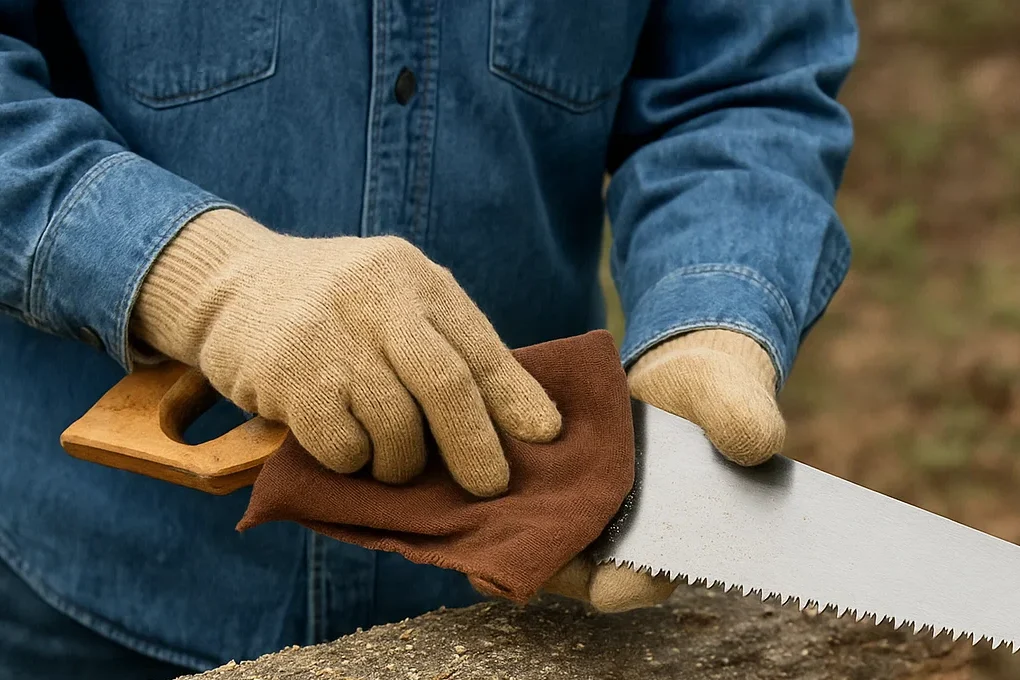
Even the best hand saw won’t last long if you let OSB wear it down without care. OSB’s glue and rough surface are hard on blades, so a few simple habits can extend your saw’s life and keep it cutting smoothly.
1. Clean the Blade After Each Use
OSB leaves behind dust, sap, and resin, especially on the teeth. If left on the blade, this buildup causes:
- Extra friction
- Slower cuts
- Faster dulling
How to clean it:
- Wipe the blade with a rag and a bit of rubbing alcohol or mineral spirits
- Avoid water (it can cause rust)
- For stubborn buildup, use a plastic scraper or an old toothbrush
2. Store It Properly
After cutting OSB, always:
- Dry the blade fully
- Store in a dry place (toolbox or wall hook)
- Avoid tossing it into piles with other tools—it dulls the teeth
3. Know When to Replace
If your saw has hardpoint teeth, it can’t be sharpened. Once it drags or burns through the wood instead of slicing clean, it’s time for a replacement.
Don’t push it, it’ll just wear you out and give poor results.
Conclusion
In short, cutting OSB well comes down to choosing a saw with 7–10 TPI, hardened teeth, a stiff 15–22″ blade, an ergonomic grip and (ideally) an anti‑friction coating to resist resin build‑up.
Our top five each hit those marks in different ways:
- HAUTMEC X‑Sharp for fast, aggressive cuts
- GreatNeck 74001 for on‑the‑fly measuring and layout
- Bahco ErgoXT for smooth, jam‑free strokes
- Jorgensen Fine‑Cut for razor‑sharp precision right out of the box
- IRWIN Universal for rapid, rough‑in cuts
Match your saw to the cuts you make—long crosscuts, plunge holes or fine trims—and you’ll cut cleaner edges, work faster and tire less.
Which one will you grab for your next project around OSB?
If you see any kind of mistake in our content, make sure to reach out to us.
Frequently Asked Questions (FAQs)
What is the best tool for cutting OSB board?
A circular saw with a straight‑edge guide or track saw delivers the cleanest, most accurate crosscuts and rip cuts on full‑size panels.
For curved or intricate cuts, a jigsaw works but at slower speed and with greater tear‑out.
Is OSB cheaper than plywood?
Yes. On average, OSB costs 10–30% less per sheet than comparable plywood (same thickness and grade).
Regional supply and demand can narrow or widen that gap, but OSB remains the budget choice for sheathing and subfloor.
Can you cut OSB with a jigsaw?
You can, but expect slower progress and rougher edges. Use a fine‑tooth, carbide‑tipped jigsaw blade, go at a moderate feed rate, and support the panel to minimize splintering.
What is the best blade for cutting OSB?
- Circular saw: Carbide‑tipped, 40–60‑tooth combination or plywood blade with a non‑stick coating for clean kerfs.
- Jigsaw: T‑shank, high‑TPI (10–12 TPI) carbide blade designed for wood and laminates.
- Hand saw: Hard‑point teeth in the 7–10 TPI range for balanced speed and edge quality.
The Grain Bros was started to serve woodworkers who can’t find products for their specific use case. We found out that there are not many media outlets extensively covering this topic. That’s why, we are here, to do the research and find the perfect products for your next DIY project. So you don’t have to juggle your tools and laptop at the same time.
If you see any kind of mistake in our content, make sure to reach out to us.

